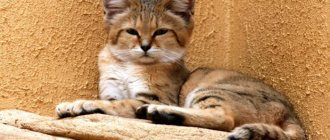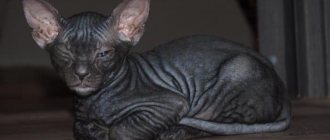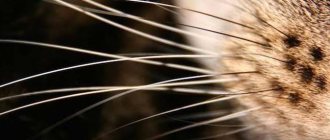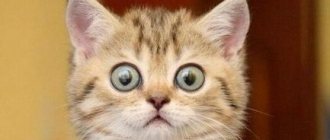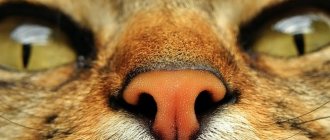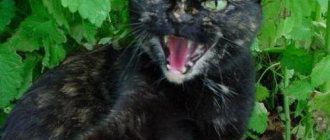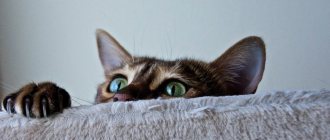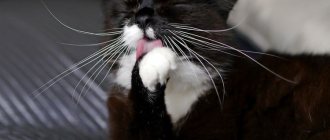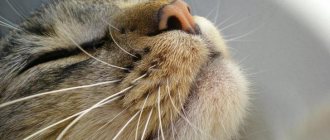What are whiskers on cats?
Scientifically, a cat's whiskers are called vibrissae. They are also called tactile hairs. By themselves, they do not feel anything, just like ordinary hairs. When the whiskers sense air movement or the animal touches something with them, they vibrate and stimulate the nerve cells located in the hair follicle. It is thanks to this feature that the vibrissae get their name.
Structure of a cat's whisker
Vibrissae are technically hairs, but they are much longer and thicker than normal hairs and are conical in shape. Compared to regular (guard) hairs, vibrissae have a larger follicle (bulb), which contains blood-filled sinuses (cavities), as well as nerve endings that connect to the somatosensory cortex - the part of the brain that is responsible for receiving and processing sensory sensations from different parts of the body.
Differences in the structure of wool and whiskers.
In many ways, whiskers perform their function by moving. Their movement is ensured by well-developed striated muscle tissue. And this is another difference from guard hairs, which are driven by smooth muscles.
Interacting with your pet
A loving owner has at least once wondered what his cat is thinking about now, what his mood is. A mustache is a means of expressing facial expressions. If you know the decoding, you can easily understand your pet’s mood. Watch her and everything will become clear. If a fluffy beauty encounters an object that interests her, her whiskers stretch forward, as if studying it.
We suggest you read: The dog has a swollen anus
There are no specially designed drugs or products to accelerate the growth of whiskers in cats. With a healthy hair follicle, the vibrissae grow on their own. There is no need for additional care. Veterinarians emphasize that there is no need to use any ointments or creams, this will not bring any benefit.
If it happens that your mustache breaks or falls off, you need to diversify your diet. It is advisable to include the following products in your daily menu:
- cottage cheese;
- vegetable oil;
- milk.
Already in the 3rd week, the hairs grow a couple of millimeters, which allows the four-legged pet to again adequately respond to the world around it. Over the next 4-10 weeks, the vibrissae acquire the required size, and their receptors are completely restored.
What kind of whiskers do cats have?
The main part of the vibrissae grows on the muzzle. They come in different lengths and perform different functions.
Vibrissae are divided into the following groups:
- supraorbital (located above the eyes),
- buccal (located on the cheeks),
- mystical (located on the sides of the mouth),
- mandibular (located on the chin).
Mystical vibrissae are conventionally divided into macrovibrissae and microvibrissae. Macrovibrissae are long and thick whiskers that usually grow to the sides and are needed so that the pet can “scan” the space around the head. They grow in four rows symmetrically on both sides of the muzzle. Each cat's pattern is unique, just like a human's fingerprint.
Microvibrissae are usually short, easily confused with regular hair, and grow downwards. They have a similar function - to read space, but microvibrissae allow cats to examine objects in more detail, while simultaneously using their senses of smell and taste.
In addition to the whiskers on their faces, cats have carpal whiskers. They can be seen on the back of a cat's paws. They help domestic predators in hunting. When a cat has caught game, the whiskers on its paws help determine whether the prey is moving and whether it is alive or not.
How do cat whiskers work?
When cats touch an object with their whiskers, they catch its outline. Signals are transmitted to the brain using nerve endings that are located in the bulb of each mustache. There are 100-200 nerve cells per whisker.
Receptors transmit information to the brain about the direction, speed and duration of whisker movement. This is how cats read the location, size, texture of an object and other information.
Loss of whiskers
Throughout their lives, cats completely change their whiskers several times. In place of the fallen ones, new ones necessarily grow, then they darken, die, fall out, and the process begins again.
Main reasons
If the loss of whiskers increases and the shift cycle shortens, the owner needs to pay attention to the living conditions of his pet in order to eliminate the cause. They may be as follows:
- In the cold season, when the owners begin to heat the room, air humidity drops and this has a bad effect on the condition of the whiskers, so it is recommended to humidify the air in various ways to improve the living conditions of pets.
- Cats are very clean animals, but sometimes people think that their pet needs help cleaning its fur. Unnecessary bathing, especially frequent, can lead to dry skin, itching, irritation, allergic reactions, even hair loss, so you should think several times before bathing your cat again.
- Changes in hormonal levels. Moving, separation from the owner, adolescence and other factors can negatively affect the condition of the mustache; in this case, consultation with a specialist is necessary.
- Some fearless cats love to admire the fire and simply singe the tips of their whiskers, so you should not leave an open fire unattended.
- Dehydration. Your pet must always have clean and fresh water in sufficient quantities. As you know, in the wild, the cat family will never drink where they dine, as the water may be poisoned, so if you notice that the animal is not drinking or drinking insufficient quantities, you can use this trick and place a bowl of water away from food.
- Lack of nutrients. If there is a deficiency of vitamins and minerals, the cat will have problems not only with its whiskers, but also with its health in general. The mustache will fall out, break, and may stop growing. It is imperative to contact a veterinarian so that he can select a diet for the animal’s speedy recovery. Food should be fresh, varied, have no chemical additives, and not be salty, sweet or sour. You should not give expired food or “yesterday’s” leftovers. You need to choose high-quality, proven brands that contain the vitamins and minerals your cat needs to maintain a healthy body.
Possible diseases
The problem with loss and brittleness of the whiskers is not always a consequence of poor animal husbandry: in some cases, these symptoms indicate an allergic reaction in the body. The most common foods that cause allergies are milk, chicken, fish, and food additives. In addition to problems with the whiskers, the cat develops itching, watery eyes, rashes on the skin, and hair may also fall out.
The problem with whisker loss can also indicate very serious diseases occurring in the animal’s body:
- Diseases of the endocrine system. It is divided into 2 types: hypothyroidism - a syndrome in which there is a decrease in the concentration of thyroid hormones. Hyperthyroidism is a clinical condition in which the thyroid gland overproduces the thyroid hormones triiodothyronine and thyroxine. The first signs of the development of one of the diseases are a sharp change in the animal’s weight, as well as thinning and loss of hairs, including whiskers.
- With the development of diabetes mellitus, the problem of vibrissae loss is also observed.
- Skin diseases. Dermatitis, fungal diseases, infections and other skin problems that cause irritation and itching can lead to hair and whisker loss.
- Various parasites that can settle on the animal’s body and inside the body can also cause vibrissae loss due to a decrease in general immunity, so it is recommended to regularly treat your pet for parasites.
Why does a cat need a mustache?
Now that we know how vibrissae work, it’s time to talk about why they are needed at all.
Cats are excellent hunters, their vision is 6-10 times sharper than humans. At the same time, they are farsighted and have difficulty seeing what is under their nose. Perhaps you noticed this when you treated your pet to a treat: you hold out your palm, on which lies an appetizing piece of yummy food, and she does not take it, but sniffs your palm, as if looking for this very piece. Don't you think the pet is really looking for a treat, and does this not only with the help of its nose, but also with the help of its whiskers. This is only one of the functions of the vibrissae.
Body position detection
Whiskers help cats determine the position of their body. The sense of one's own body is scientifically called proprioception. It is provided by proprioceptors, or sensory receptors. In cats, these receptors are located in the place where the whiskers grow. Receptors send information to the brain about the position of the body and limbs in space, thus helping the cat feel every part of its body. It is believed that this is why cats land on their feet in most cases.
Navigation
Another function of vibrissae is navigation. The whiskers are very sensitive to air vibrations and react to the slightest changes, they work like a radar.
When cats approach something in their path, they create vibrations in the air that bounce off the object. The animal picks up these vibrations with its whiskers and reads information about surrounding objects.
In the wild, this function helps determine the location of prey and relatives. This feature helps domestic cats navigate the house at night - cats can easily find bowls and toys in the dark and avoid obstacles.
Protection
Vibrissae protect. Cats' eyes are very sensitive; even a small speck of dust can damage them. When such a speck of dust falls on the whisker above the eye, the cat feels it, blinks and shakes its head to shake off the speck of dust.
When a cat walks and touches long blades of grass or branches of bushes with its whiskers, it understands where the obstacle and potential danger are, because a blade of grass can touch an eye, and a bush can have thorns. Vibrissae warn of danger and allow you to choose a safer direction.
Whiskers help avoid getting stuck in crevices. Their length, on average, corresponds to the width of the animal’s body. When a cat approaches a narrow place, such as a hole in a fence, the whiskers help determine whether it can fit through the hole. If the hole is much smaller than the width of the whiskers, the cat understands that it cannot fit through here.
Sometimes a cat's life depends on its whiskers - they help sense danger and determine where the enemy is.
Whiskers help cats hunt and recognize obstacles.
Communication
By the position of the whiskers, you can determine the mood of the pet. For example, when you play with your pet, you may notice that his whiskers point forward. This is because the animal is in hunting mode. When a cat is frightened, it seems to hide its whiskers - they are pressed against its cheeks. In general, when the pet is calm, the whiskers are also in a calm state. When something bothers a cat, it tenses and fluffs them up.
Cat's whisker tongue
If the animal is in a calm state, then its whiskers are relaxed.
An attentive owner may notice that the pet’s whiskers are in different positions. If a cat's whiskers are pressed to its muzzle, it means that it is scared of something or is worried about something. This situation also indicates that the animal is angry and may show aggression.
If your pet's coarse hair points forward, it means he is curious or ready to interact. When he sleeps, his muzzle with mustache is relaxed. Knowing these subtleties will help you determine when you need to play with your cat or calm him down.
Why do my mustaches fall out?
Hair loss is a normal process. Cats lose their whiskers in the same way as they lose their fur, this is a process of shedding. Normally, cats lose one or two whiskers at a time. You already know that they have many important functions, so they cannot all fall out at once - without whiskers, the cat will have a very difficult time. But it happens that the mustache falls out for other reasons.
Allergy
Losing mustaches may indicate an allergy. Cats' bodies often react to allergens with dermatological problems, such as skin irritation. Most often, mustache loss is a consequence of food allergies.
Infection
If an infection or fungus appears in the place where the whiskers grow, they can cause the whiskers to fall out. Bacterial infections such as ringworm can also cause hair loss.
Injuries
If the cat is injured in the place where the whiskers grow - for example, his whiskers and eyebrows are damaged - they may fall out. It's not just other animals that can cause injury. If a pet unsuccessfully rubs its muzzle against a tree or crashes into a wall in the midst of play, this can also cause it to fall out.
Cat acne
Cats, like people, get acne. Acne usually forms in the chin area. But it can spread to the cheeks and thus contribute to mustache loss. The main cause of acne is bacteria that grows on your cat's bowls. For prevention, it is better to use ceramic or metal bowls and wash them frequently.
Lost mustaches grow back. But if the loss is associated with veterinary problems, you need to solve these very problems first. Take your pet to a veterinarian, he will help determine the cause and select treatment if necessary.
Sometimes mustache loss is due to lack of nutrients. If the analysis shows that the animal is lacking something in its diet, it will have to be adjusted. The health of the coat and the whole body as a whole will be helped by providing SUPERPET species-typical nutrition. This food takes into account all the needs of cats and provides all the necessary macro- and microelements.
For your pet’s health, veterinarians recommend SUPERPET, a biologically appropriate diet.
Types and degrees of burns
The reasons for getting burns can be different. Careless behavior of the owners and active curiosity of the cat can lead to injury. Your pet may suffer the following burns:
Read also:
